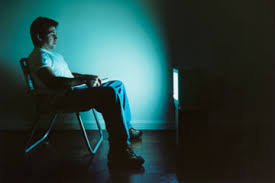

In today’s digital age, televisions are central to home entertainment.
However, improper placement, especially positioning the screen too low, can adversely affect our posture.
This article by BestForwardHeadPostureFix explores, in a detailed stepwise manner, how viewing a low-positioned TV contributes to forward head posture (FHP), focusing on the specific muscles and body structures affected at each stage.
Points Covered in this Article:
- Ideal Head and Neck Alignment
- Description of optimal posture
- Role of the cervical spine’s natural curvature
- Muscles supporting proper alignment:
- Erector Spinae Muscles
- Deep Cervical Flexors (Longus Colli and Longus Capitis)
- Initial Forward Tilt of the Head
- Consequences of a low-positioned TV screen
- Shift in head’s center of gravity
- Increased load on the cervical spine
- Quantifying the additional strain per inch of forward head movement
- Muscle Compensation and Imbalance
- Overactive muscles:
- Suboccipital Muscles
- Upper Trapezius and Levator Scapulae
- Weakened muscles:
- Deep Cervical Flexors (Longus Capitis and Longus Colli)
- Examples illustrating muscle imbalances
- Approaches to address these imbalances
- Altered Spinal Curvature
- Increased Cervical Lordosis
- Development of Thoracic Kyphosis
- Implications of these changes on overall posture
- Joint and Ligament Strain
- Facet Joint Compression
- Ligamentous Strain
- Potential conditions arising from joint and ligament stress
- Development of Trigger Points
- Definition and characteristics of Myofascial Trigger Points
- Symptoms associated with trigger points
- Examples of referred pain patterns
- Strategies for managing trigger points
- Neurological Implications
- Nerve Compression resulting from FHP
- Symptoms such as numbness, tingling, and weakness
- Conditions like cervical radiculopathy
- Impact on daily activities and quality of life
- Respiratory Function
- Effect of FHP on diaphragm function
- Consequences for breathing efficiency
- Potential decrease in oxygen intake and endurance
- Importance of postural correction for respiratory health
- Degenerative Changes
- Acceleration of degenerative processes in cervical vertebrae and discs
- Development of conditions like cervical spondylosis
- Long-term effects on neck mobility and comfort
- Conclusion
- Recap of the importance of proper TV screen positioning
- Encouragement to adopt ergonomic practices
- Final thoughts on maintaining good posture for overall health
Ideal Head and Neck Alignment
In an optimal posture, the head aligns directly over the shoulders, maintaining the natural curvature of the cervical spine.
This alignment ensures that the weight of the head, approximately 10 to 12 pounds, is evenly distributed, minimizing strain on the cervical vertebrae and surrounding musculature.
The muscles supporting this posture include:
- Erector Spinae Muscles: These muscles run along the spine and are responsible for extending and stabilizing the vertebral column. They play a crucial role in maintaining an upright posture.
- Deep Cervical Flexors: Muscles such as the longus colli and longus capitis are located at the front of the cervical spine. They help in flexing the neck and maintaining the natural curve of the cervical spine.
Initial Forward Tilt of the Head
When a television screen is positioned below eye level, viewers naturally tilt their heads downward to focus on the screen.
This initial forward tilt shifts the head’s center of gravity anteriorly, increasing the load on the cervical spine.
For every inch the head moves forward, the weight exerted on the spine increases by approximately 10 pounds.
This added strain requires greater muscular effort to support the head, leading to muscle fatigue and imbalance.
Muscle Compensation and Imbalance
Forward Head Posture (FHP) leads to specific muscle imbalances, where certain muscles become overactive and tight, while others weaken due to underuse.
Understanding these changes is crucial for addressing the associated discomfort and preventing further complications.
Overactive Muscles:
- Suboccipital Muscles: Located at the base of the skull, these muscles become strained in individuals with FHP, often leading to tension headaches. For example, someone who spends extended periods looking down at a smartphone may experience persistent headaches due to the overactivity of these muscles.
- Upper Trapezius and Levator Scapulae: Situated at the back of the neck and shoulders, these muscles become overactive and strained in individuals with FHP, leading to neck and shoulder pain. For instance, an office worker who consistently hunches over a computer may develop tightness and discomfort in these areas.
Weakened Muscles:
- Deep Cervical Flexors (Longus Capitis and Longus Colli): Located along the front of the cervical spine, these muscles become weakened due to underuse in individuals with FHP, leading to muscle imbalance. For example, a person with a slouched posture may find it challenging to maintain an upright head position because these stabilizing muscles have weakened over time.
Addressing FHP involves stretching the overactive muscles and strengthening the weakened ones to restore balance and alleviate discomfort.
Altered Spinal Curvature
Forward Head Posture (FHP) leads to specific muscle imbalances, where certain muscles become overactive and tight, while others weaken due to underuse.
Understanding these changes is crucial for addressing the associated discomfort and preventing further complications.
Overactive Muscles:
- Suboccipital Muscles: Located at the base of the skull, these muscles become strained in individuals with FHP, often leading to tension headaches. For example, someone who spends extended periods looking down at a smartphone may experience persistent headaches due to the overactivity of these muscles.
- Upper Trapezius and Levator Scapulae: Situated at the back of the neck and shoulders, these muscles become overactive and strained in individuals with FHP, leading to neck and shoulder pain. For instance, an office worker who consistently hunches over a computer may develop tightness and discomfort in these areas.
Weakened Muscles:
- Deep Cervical Flexors (Longus Capitis and Longus Colli): Located along the front of the cervical spine, these muscles become weakened due to underuse in individuals with FHP, leading to muscle imbalance. For example, a person with a slouched posture may find it challenging to maintain an upright head position because these stabilizing muscles have weakened over time.
Addressing FHP involves stretching the overactive muscles and strengthening the weakened ones to restore balance and alleviate discomfort.
Joint and Ligament Strain
Forward head posture (FHP) imposes additional stress on the cervical spine’s joints and ligaments, leading to various complications:
Facet Joint Compression:
Facet joints, located between vertebrae, facilitate smooth movement and provide stability to the spine.
In FHP, the head’s forward displacement increases the load on facet joints.
This unnatural positioning places additional stress on the intervertebral discs, vertebrae, and facet joints, potentially exacerbating or accelerating spinal degeneration.
Over time, this increased pressure can lead to pain, reduced mobility, and conditions such as facet joint syndrome.
Ligamentous Strain:
Ligaments are connective tissues that stabilize the spine by connecting bones.
In FHP, the forward positioning of the head causes a slow stretching of posterior neck ligaments, a phenomenon known as ligament creep.
This overstretching leads to instability and discomfort, as the ligaments are unable to maintain proper alignment of the cervical vertebrae.
Prolonged ligamentous strain can result in chronic neck pain and increase the risk of injuries due to reduced spinal support.
Understanding these impacts highlights the importance of maintaining proper head and neck alignment to prevent undue stress on the cervical spine’s joints and ligaments.
Development of Trigger Points
Chronic muscle strain and imbalances can lead to the development of myofascial trigger points—hyperirritable spots within taut bands of skeletal muscle fibers.
These trigger points are tender upon palpation and can cause referred pain, leading to headaches and neck pain.
For example, a trigger point in the trapezius muscle may result in tension headaches.
Similarly, trigger points in the sternocleidomastoid muscle can refer pain to the forehead or behind the eyes.
Understanding the development and impact of these trigger points is crucial for effective management and relief of associated symptoms.
Neurological Implications:
Prolonged forward head posture (FHP) can significantly impact nerve function, primarily through nerve compression.
This compression occurs when the misalignment of the cervical spine exerts pressure on nerve roots, leading to various neurological symptoms.
Nerve Compression:
In FHP, the head’s forward displacement increases stress on the cervical spine, potentially causing intervertebral disc herniation or osteophyte formation.
These structural changes can compress nerve roots, resulting in symptoms such as numbness, tingling, and weakness in the upper extremities.
For instance, cervical radiculopathy, commonly known as a pinched nerve, manifests these symptoms due to nerve root inflammation or injury.
Individuals may experience radiating pain from the neck into the shoulders, arms, or hands, accompanied by muscle weakness or diminished reflexes.
Persistent nerve compression can lead to chronic discomfort and functional impairments, affecting daily activities and overall quality of life.
Recognizing the link between FHP and nerve compression underscores the importance of maintaining proper posture to prevent neurological complications.
Addressing FHP through ergonomic interventions and therapeutic exercises can alleviate nerve compression symptoms and promote spinal health.
Respiratory Function:
Forward head posture (FHP) can significantly impair respiratory function by altering the mechanics of breathing.
In FHP, the head’s forward displacement affects the alignment and mobility of the thoracic spine and ribcage, leading to compromised diaphragm function.
This posture-induced alteration can impede the diaphragm’s ability to contract and relax efficiently, resulting in reduced lung volumes and diminished respiratory efficiency.
Consequently, individuals may experience decreased oxygen intake, reduced overall endurance, and increased fatigue during physical activities.
Addressing FHP through postural correction and targeted exercises is essential to restore optimal diaphragm function and enhance breathing efficiency.
Degenerative Changes
Chronic forward head posture (FHP) can significantly accelerate degenerative processes in the cervical vertebrae and intervertebral discs.
When the head is positioned forward relative to the spine’s neutral alignment, it increases the load on the cervical spine.
This additional stress places excessive pressure on the vertebrae and discs, leading to premature degeneration.
Over time, this misalignment can cause structural changes, including the development of bone spurs and reduced disc height.
These changes may contribute to conditions such as cervical spondylosis, which is characterized by stiffness, pain, and reduced mobility in the neck.
As the intervertebral discs wear down, they lose their ability to absorb shock, further increasing stress on the surrounding joints and tissues.
In more severe cases, degeneration can lead to nerve root compression, causing neurological symptoms such as numbness, tingling, or weakness in the arms and hands.
Addressing FHP through postural awareness and strengthening exercises is crucial in preventing long-term damage to the cervical spine.
FAQs on How Low TV Screen Causes Text Neck
Q-1: Why Does A Low TV Screen Cause Forward Head Posture?
A-1: When the screen sits below eye level, you naturally tip your chin down to see it. That small tilt shifts your head’s center of mass forward, so the neck and upper-back muscles must “hold” the head against gravity. Over a show (or three), this repeated flexed position stiffens muscles, compresses joints, and trains a forward-head habit even when you’re not watching TV.
Q-2: How Much Extra Load Does “Looking Down” Put On My Neck?
A-2: Far more than most people expect. Estimates suggest the effective load on the cervical spine jumps from roughly 10–12 lb in neutral to about 27 lb at 15°, ~40 lb at 30°, and ~60 lb at 60°. A low screen nudges you toward those angles, so long viewing sessions can feel like your neck is doing a mini workout—without the benefits.
Q-3: What’s The Ideal TV Height To Help My Neck?
A-3: Aim for eye level when seated. A simple rule: the top of the TV at or just below your eyes, with the screen center about 15–20° below your straight-ahead gaze. Keep the screen directly in front of you (no twisting), sit at a distance of roughly 1.5–2.5× the screen diagonal, and relax your shoulders so your ears stack over your shoulders.
Q-4: Are There Recent Red Flags About Low Screens Beyond TVs?
A-4: Absolutely. The same “tech-neck” pattern shows up with phones and laptops—downward gaze, rounded shoulders, and neck strain.
The fix is universal: raise screens toward eye level, keep your chest open, and sprinkle in breaks.
If your living-room setup points your chin down, your neck will remind you later with stiffness or headaches.
Q-5: Quick Fixes If My TV Is Low And I Can’t Remount Today?
A-5: Sit on a firm cushion to lift your eye line, add a tilting stand or a few sturdy risers under the TV, and angle the screen so your gaze meets it naturally.
Center the TV to avoid head rotation, brighten the room to prevent squint-and-chin-tuck, and take 30–60-second micro-breaks every 20–30 minutes for chin tucks, chest stretches, and gentle neck moves.
Conclusion:
In the grand theater of home entertainment, your television’s position plays a leading role in your viewing comfort.
Mounting your TV too low can encourage forward head posture (FHP), leading to various musculoskeletal issues. According to guidelines from CE Pro, a 55-inch TV should be mounted about 61 inches from the floor to the center of the screen, while a 65-inch TV should be at 65 inches.
By adopting ergonomic practices and being mindful of screen positioning, you can maintain proper posture and reduce the risk of associated health problems.
So, give your TV the spotlight it deserves—at the right height—and let your neck enjoy the show without any drama.
References:


